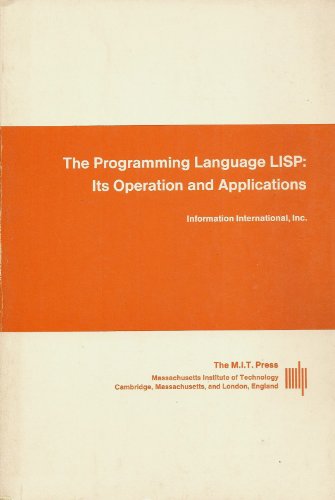
The Programming Language LISP: Its Operation and Applications
by E.C. Berkeley, D.G. Bobrow
Publisher: The MIT Press 1966
ISBN/ASIN: B0000CNAAU
ISBN-13: 9780262590044
Number of pages: 395
Description:
The language LISP, short for 'LISt Processing' language, is a remarkable and powerful language, because not only does it govern the operation of a computer, but also it is a mathematical language of great flexibility and power for processing processes in mathematics, logic, and symbol manipulation in general.
Download or read it online for free here:
Download link
(12MB, PDF)
Similar books
 GNU Emacs Lisp Reference Manual
GNU Emacs Lisp Reference Manualby Bil Lewis, Dan LaLiberte, Richard Stallman - Free Software Foundation
This manual attempts to be a full description of Emacs Lisp. Emacs Lisp is more than a mere 'extension language'; it is a full computer programming language in its own right. You can use it as you would any other programming language.
(15906 views)
 Loving Lisp, or the Savvy Programmer's Secret Weapon
Loving Lisp, or the Savvy Programmer's Secret Weaponby Mark Watson
This book is an introduction to Common Lisp. The author considers Common Lisp to be twice as good as Java for some applications. Common Lisp compilers are freely available, stable, and compiled Common Lisp code is very fast.
(22435 views)
 LISP 1.5 Programmer's Manual
LISP 1.5 Programmer's Manualby John McCarthy - The MIT Press
The LISP language is designed primarily for symbolic data processing used for symbolic calculations in differential and integral calculus, electrical circuit theory, mathematical logic, etc. The manual describes LISP, a formal mathematical language.
(9004 views)
 Common LISP: A Gentle Introduction to Symbolic Computation
Common LISP: A Gentle Introduction to Symbolic Computationby David S. Touretzky - Benjamin-Cummings Pub Co
This is a gentle introduction to Common Lisp for students taking their first programming course. No prior mathematical background beyond arithmetic is assumed. There are lots of examples, the author avoided technical jargon.
(27566 views)